Art World
After Decades of War and Political Instability, Is Baghdad’s Art Scene Seeing Glimmers of a Revival?
An influx of private and public funding could signal cultural renewal in war-torn Iraq.
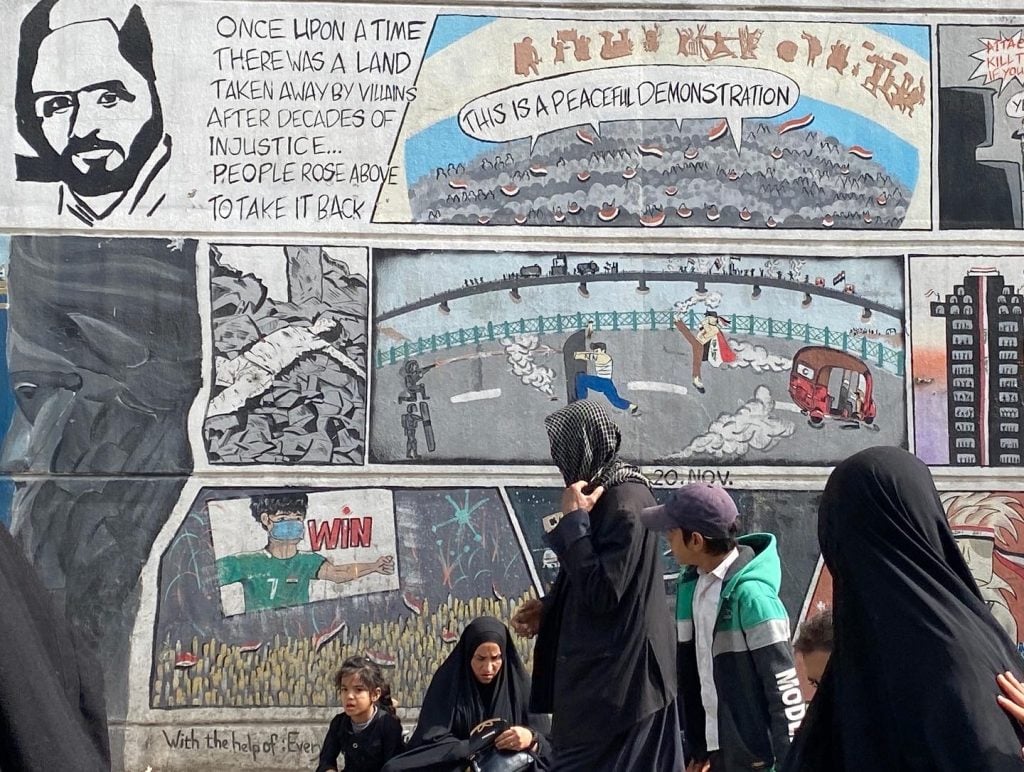
An influx of private and public funding could signal cultural renewal in war-torn Iraq.

Rebecca Anne Proctor

In Baghdad’s Tahrir Square—the site of violent anti-government demonstrations that began in 2019—bold, expressive, street art stands as a reminder that the Iraqi battle for a better life is not over.
Though the protests, also known as the October Revolution, led to the resignation of Iraq’s prime minister in November 2019, and his successor has pledged to crack down on corruption and improve services and unemployment rates in the country, not much has changed. Political uncertainty, frequent electricity shortages, corruption, and attacks by extremist groups characterize the Iraq of today. The country, once the pinnacle of culture and heritage for the Arab world, has endured this state of affairs for more than 30 years.
Baghdad’s art scene has also suffered. At one time home to around 15 art galleries, just four commercial spaces have survived the upheaval, despite the fact that Iraqi art is highly in demand. Iraqi antiquities such as the 3,000-year-old Assyrian relief that sold at Christie’s for more than $30 million in 2018, are widely coveted, major works by Iraqi modernists from the 1960s regularly sell at auction in the range of $30,000 to $1.2 million, and contemporary art by stars such as Dia Azzawi (who has resided in London since 1976), can fetch $235,000.
But the conflict led to a significant brain drain from the region. “Thousands of artists and art teachers left after 2003 to live elsewhere in the region or abroad,” Henaa Malallah, a renowned Iraqi female artist, told Artnet News from London, where she now lives after fleeing her home in 2006. “It is a traumatized art scene.”
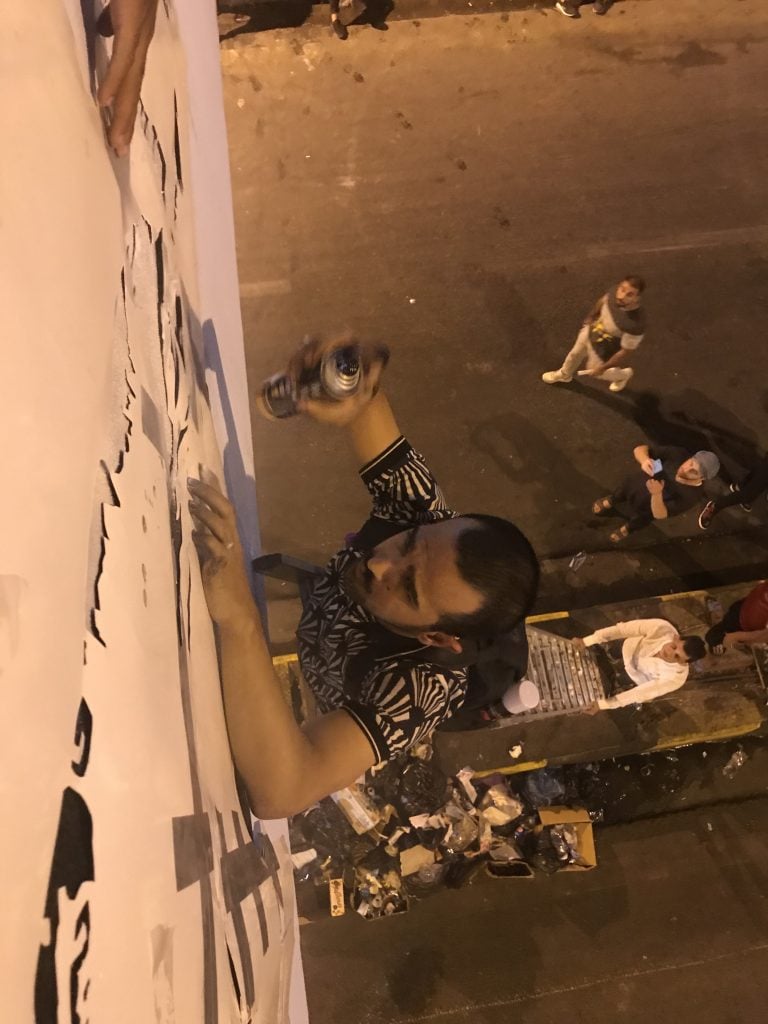
Courtesy Sajjad Abbas.
There is little to no government support for artists or artist initiatives in today’s Baghdad. The main support for artists in the capital and elsewhere in the country is through the Iraqi Artist Syndicate and the Iraqi Fine Artists Association. Both are non-governmental organizations that rely on donations. (The latter uses money made at a bar and restaurant to support artists and stage exhibitions).
Others include the not-for-profit Ruya Foundation, which was established in 2012 to support contemporary Iraqi art, and has staged the Iraq Pavilion at the Venice Biennale since 2013. Ruya opened its own commercial gallery in 2018 on Al-Mutanabbi Street, but the foundation will not participate in the Biennale this year due to lack of funding and other, pandemic-related, challenges.
Further difficulties stem from Iran-backed militias who demand protection money from Iraqi gallery owners like Qassem Sebti, an Iraqi artist and founder of Hewar Gallery, and the head of the Iraqi Fine Artists Association, taking away sums that could go to support artists.
The state of Baghdad’s revered National Museum of Modern Art is a powerful mirror to the plight faced by its contemporary art scene. Once a treasure chest of thousands of priceless 20th-century Iraqi works of art, it was looted during the collapse of the Ba’ath regime in 2003 and the U.S. invasion. Around 7,000 paintings and sculptures from the museum’s collection of 8,000 were stolen, and have traded hands on the black market ever since, with a few thousand reclaimed in recent years. Its storage area is in tatters, with no temperature control, and canvases are stacked in disarray—some even ripped and lying on the ground.
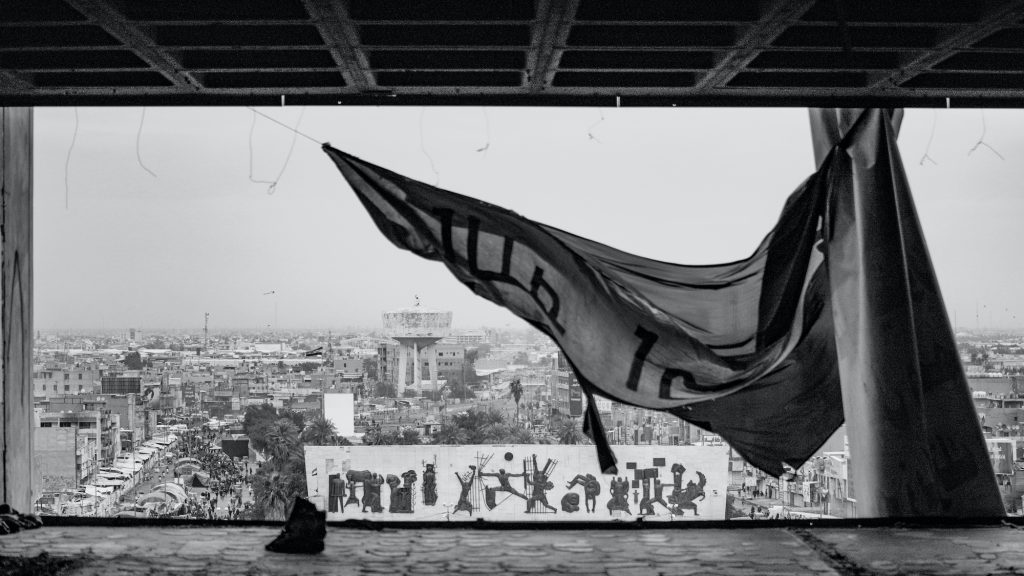
A view of Tahrir Square from inside the building of the Turkish restaurant, which was taken over by revolutionaries, 2019. Ayman Al-Amiri.
Yet even amid these woes, the light of Baghdad’s art scene—just like the beams that emanate from meticulously crafted and patterned minarets throughout the city—never went completely out. Iraqi artists and art professionals proudly assert that even during the worst of the war, the art scene was always active.
“We never closed the school, sometimes we would sleep in the classrooms and teach and paint,” said Mohammed Al-Kinani, head of the visual art department at Baghdad’s College of Fine Arts, one of the country’s two art institutions. “Sometimes people who write history lie but art never lies.”
Art creation became itself an act of protest and resilience during the turbulence, with artists often receiving death threats due to their work. Artist Akeel Khreef, who works predominantly with found objects, recently created a large installation using empty tear gas canisters from the protests. “After 2003 I began looking at materials from everyday life and Baghdad was a damaged city,” Khreef told Artnet News. “I witnessed people being killed, their bodies being thrown down the streets and I created work about what I saw.”
In another series, made in 2015, he depicted ISIS. Upon seeing the works, a member from the Islamic militant group contacted him on Facebook and threatened to cut his head off if he created any more work about ISIS. Since then, Khreef has only shown the series in the U.K. and the Netherlands, but plans to exhibit it at The Gallery, a sleek commercial art gallery in Baghdad that opened in October 2021, later this year.
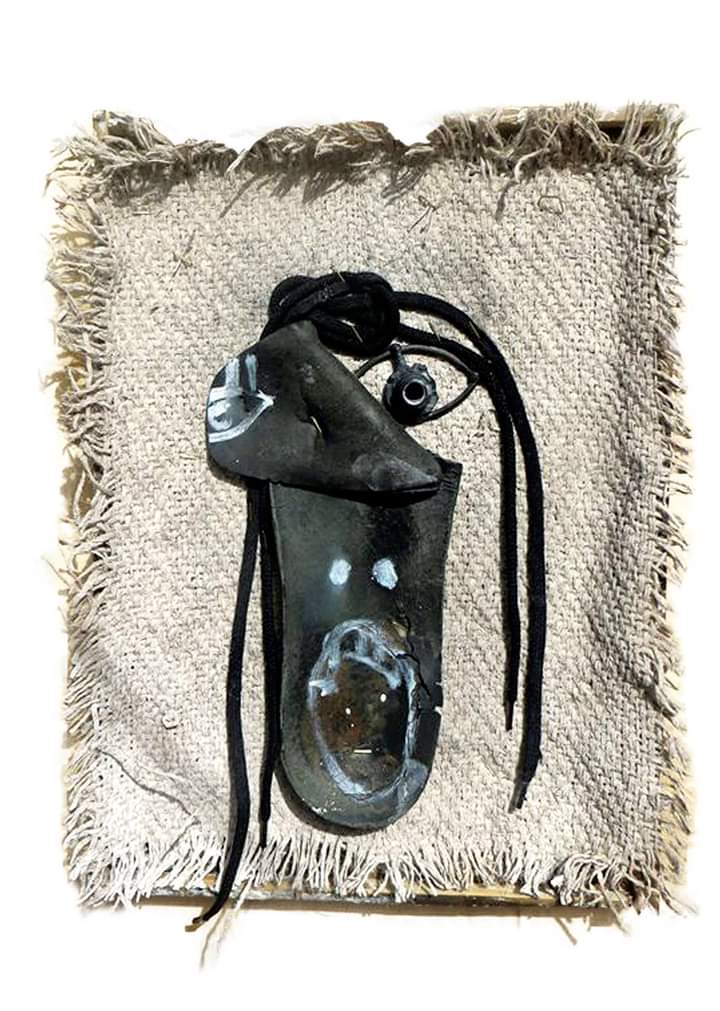
Work by Akeel Khreef. Courtesy the artist.
The opening of The Gallery is part of a number of encouraging signs of a cultural revival in Baghdad in recent months, thanks to a mix of private and public sector initiatives. At the end of December 2021, the city’s famed book market, Al-Mutanabbi Street, was renovated with funding from the Iraq Private Banks League, an association of private banks in Iraq.
Ali Tariq, the organization’s executive director, told Artnet News that it has helped to restore 21 main squares in Baghdad since 2018 out of a sense of responsibility. “We have done a lot for culture and art over the past three to four years because there has not been much support for this community,” Tariq said.
While the league claims to be a non-governmental-organization, its official fund is held by the Central Bank of Iraq, and it is chaired by Wadeaa Al-Handal, who is also the governor of the central bank. Tariq explained that its funding comes from monthly donations from Iraqi commercial banks, or “in special cases” from the central bank itself. Some of the new art and lifestyle spaces in Baghdad’s Karada district, including The Gallery, have been funded by the Al Handal Group, which is operated by the Al-Handal family (of which Wadeaa Al-Handal is a member.)
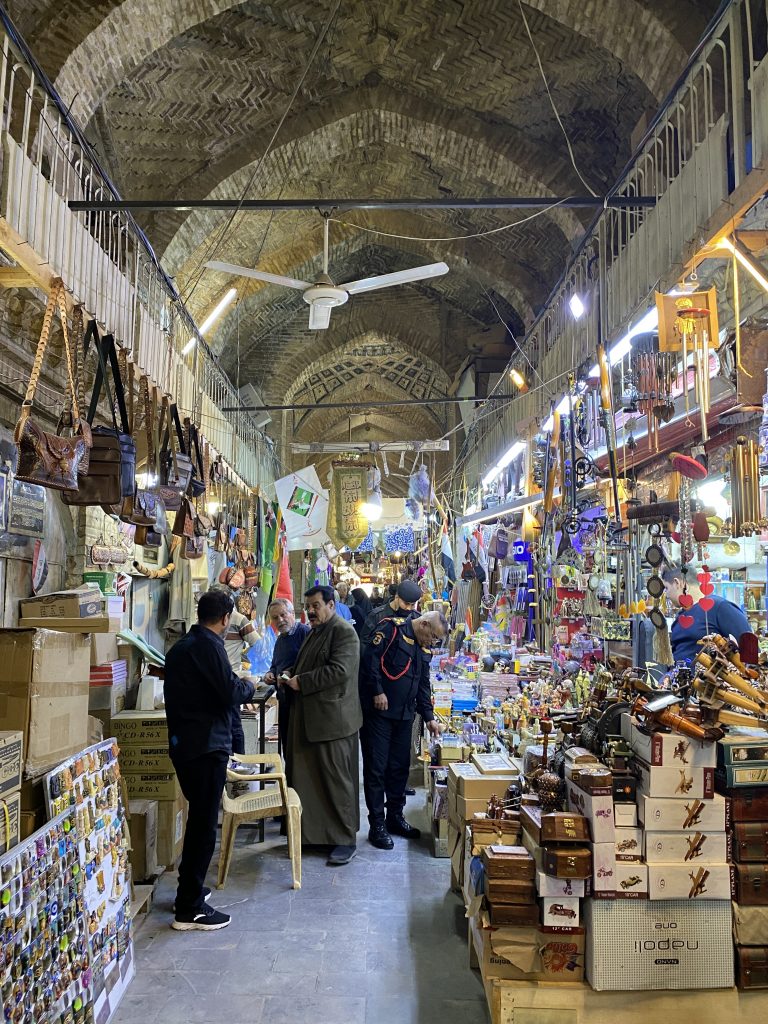
A restored Al-Mutanabbi Street. Photo by Rebecca Anne Proctor.
On view at The Gallery now is “The Baghdad Gazette,” an exhibition of works by Iraqi female artist Furat al Jamil and photographer Ayman Al Amiri, who also works for the news agency Agence France-Presse. “Iraqis don’t read the newspaper much anymore because the news is always so negative, so Furat and I created an imaginary newspaper discussing the situation in Iraq through images and fictional stories and poetry,” Al Amiri told Artnet News. “It’s important for people in Iraq to start to dream again because they stopped.”
Another venue under the Al Handal Group’s umbrella is The Station—Baghdad’s first co-working space that opened in 2018 and also has an art gallery, is a central space for Iraqi youth. In 2020 it expanded to Mosul in Northern Iraq and will open another site in Erbil, Kurdistan, later this month.
Members from the Baghdad art scene who fled after the invasion are also now returning to the country. On the second floor of a building in Karada is Akkad Gallery, dedicated to modern and contemporary Iraqi art. Its founder, Haider Hashem, returned at the end of 2021 from Turkey, where he had been living since the U.S. invasion.
Meanwhile, an uptick in tourism could bring good things to the city’s artistic community. The government has been granting tourist visas to citizens of a dozen countries, including the U.S., China, U.K., Russia, and E.U. member states since March 2021, and in January, Baghdad’s mayor Alaa Maan commissioned large murals throughout the city dedicated to major Iraqi historical and contemporary figures, including the late architect Zaha Hadid, and prominent poets, writers and artists.
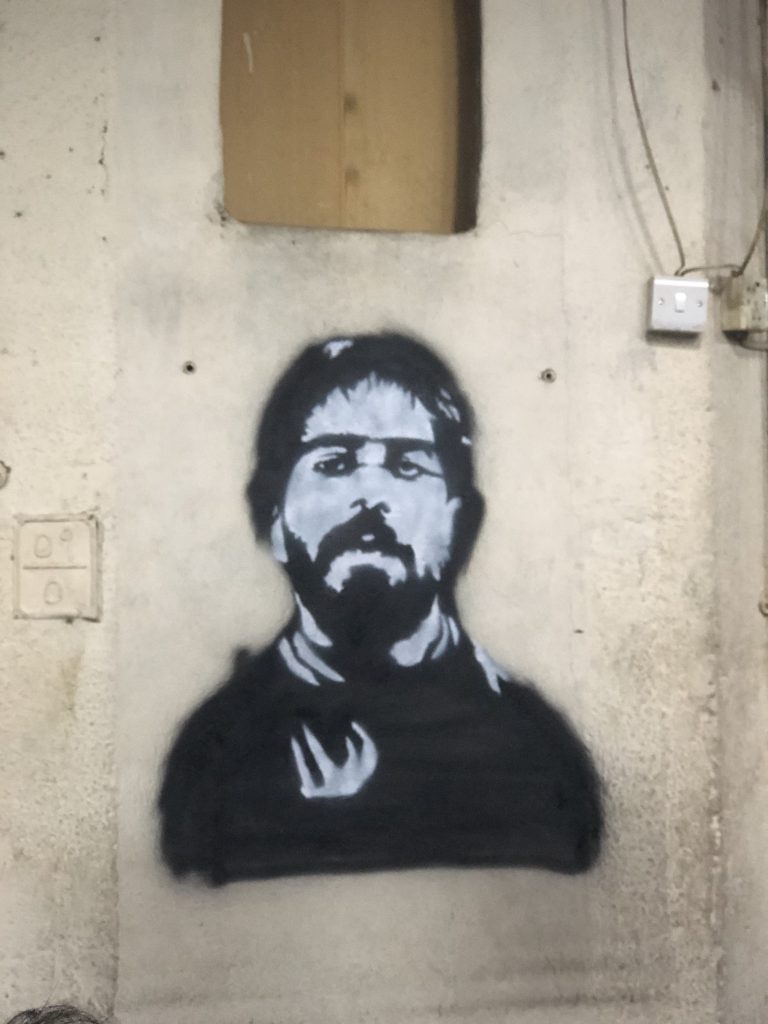
Safaa al-Sarai by Sajjad Abbas, courtesy the artist.
Some leaders within Baghdad’s art scene, however, are keeping a critical eye on private investment in the art scene and what they see as short-sighted goals from the ministry of culture.
Multimedia artist Sajjad Abbas, who created one of the most recognizable images from the protests—a stencil of the young artist and poet, Safaa al-Sarai, who was killed by a smoke grenade—doesn’t want anything to do with the “new art spaces” that have opened.
“I want to create real art, not participate in fancy galleries in Iraq trying to cover something,” he said. To Abbas, support for Iraqi artists means supporting their education—a lot of his practice has involved engaging Iraqi youth to participate in the protests by creating art and writing slogans around the city.
“It is good to see these changes, but they are cosmetic and not deep,” Saad Eskander, the acting director of the National Museum of Modern Art, told Artnet News. “When you renovate Al-Mutanabbi Street or any place of heritage or importance you need to preserve the intangible heritage—the expertise—and we don’t, so what is the point of doing these shows? We don’t have a vision as a ministry and as a country as to how to protect our heritage.”
While Iraq’s brave and defiant artists continue to create their art, one thing is clear: they need more options for exhibitions, studio space, and commercial opportunities. And for future generations, vital investment in art education is necessary to ensure the cultural scene is able to to live up to its potential. The glimmer of artistic revival in Baghdad could signal change for the war weary nation, but there is still a long way to go.